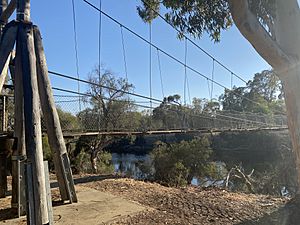Suspension Bridge, York facts for kids
Quick facts for kids Designations |
|
|---|---|
| Type | Shire of York heritage list |
| Designated | 31 December 1995 |
| Reference no. | 2889 |
The Suspension Bridge in York, Western Australia is a special bridge just for people to walk on. It's built with strong steel cables and wooden planks. This bridge crosses the Avon River, connecting the main part of town with the Holy Trinity Church. It's a famous landmark and a popular spot for visitors.
Contents
Building the First Bridge
In 1888, people living on one side of the Avon River asked the York town council for a bridge. The council agreed to build a walking bridge right in the middle of town.
A clever engineer named Henry E Parry designed the first bridge. James Butterly was chosen to build it for £75. Work on the bridge started in August 1888.
The bridge officially opened on 24 October 1888. The Governor, Sir Frederick Broome, was there for the opening. He walked across the bridge, followed by many important people. This was the very first suspension bridge ever built in Western Australia!
The first bridge was paid for by the York Municipal Council and by donations from local people.
Since at least 1890, some people have also called it the Swing Bridge. However, it's actually a suspension bridge, not a swing bridge.
After the bridge opened, there were some problems. People complained about vandalism, like gates being broken. The council also worried about bicycles damaging the wooden walkway.
Big floods happened in 1891 and 1893, with the river flowing over the bridge. But the bridge survived! It was made wider and repaired in 1894.
Moving the Bridge
When the first suspension bridge was built, it was the only bridge for people in the town centre. Other bridges were further away and sometimes broken.
In 1896, a new bridge for traffic was built nearby. The York Municipal Council then decided to move the suspension bridge. They moved it about 200 metres north to Pool Street. The new spot meant the bridge had to be about 7 metres longer.
The lowest bid to move the bridge came from Davis & Flight, costing £49/15/6. This work began in December 1896 and finished by January 1897. People used the relocated bridge a lot.
Rules and a Horse Problem
In 1897, there were complaints about people swimming too close to the bridge without proper swimsuits. By 1905, the council made rules that boys and men had to wear bathing pants. They also made separate swimming times for men and women.
In 1903, a horse wandered onto the bridge and caused a lot of damage. After this, the council decided to put spinning gates, called turnstiles, at each end. These would stop horses and other animals from getting onto the bridge.
Storms, Floods, and a New Bridge
On 2 March 1909, a big storm hit. It washed a lot of dirt onto the eastern side of the bridge. This dirt had to be removed to stop pressure on the bridge.
The storm was so strong that it even damaged the nearby cemetery. One newspaper joked that three coffins were washed onto the suspension bridge!
Repairs were done in April 1909, but they were delayed because special cables were hard to find.
Then, in August 1909, heavy rains caused another big flood. The suspension bridge went underwater, putting a lot of strain on its supports. Because of this, the York Municipal Council decided to build a brand new suspension bridge.
Work on the new bridge started in March 1910. It was built by council workers and paid for by the York Municipal Council.
There was some debate about how the new bridge was being built. But a skilled engineer named Charles Hasforth assured everyone it was well designed. He said the new bridge could hold twice as many people as the old one.
Bridge Collapse
In August 1946, something surprising happened. About 30 hikers, including children, were on the bridge. They were swinging it back and forth for fun when a cable suddenly snapped! All 30 people fell into the river.
One woman's leg got caught in the wire netting. Many people lost their shoes, bags, and hats. But luckily, no one was seriously hurt, just wet! The hikers lit a fire to dry their clothes. Some local people also helped by giving them warm clothes. St John Ambulance workers arrived to check if anyone was injured.
Rebuilding in 1988
Over time, the bridge became old and unsafe. It was closed in the early 1980s. But in 1988, it was rebuilt to celebrate its 100th birthday!
Today, the Suspension Bridge is still used a lot. The Shire of York takes good care of it. It remains a very popular place for both locals and tourists to visit.


